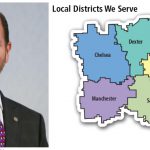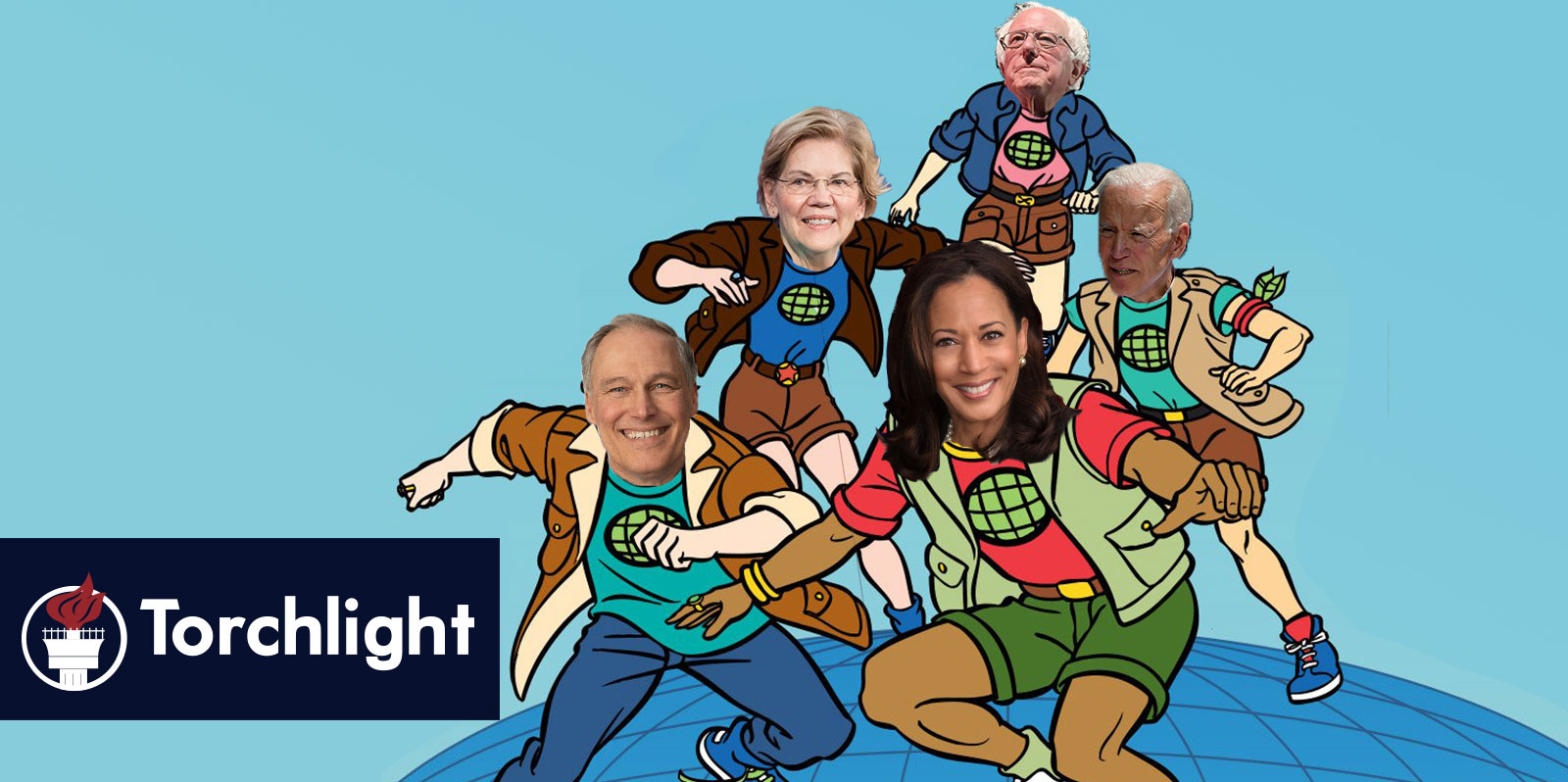Climate change is one of the most serious existential threats to our nation and planet today. We are already feeling the effects, and unless we take some serious measures, they will only accelerate. Our current president does not seem to understand the issue, saying “It changes both ways”. His chief of the NSC consults with climate change deniers. His chief of the EPA is a coal lobbyist. And he still hasn’t backed off claims it is a Chinese hoax, which is not true. In about a year and a half, voters are going to choose between this man and one other person to run the country. Their opinions on climate change matter very much.
The most significant plan to help mitigate and prevent the consequences of climate change is the Green New Deal, which describes a plan to move our power generation of coal and oil, revitalize the economy, and upgrade our infrastructure. 14 of the 24 candidates have voiced support (or sponsored) the Green New Deal. However, while the Green New Deal is a wonderful outline to follow, there are candidates with more substantive and granular plans. Many candidates also bind their climate plans with a plan to refocus the economy away from resource extraction, because lowering emissions also lowers the demand for oil and coal, which would have knock on effects that should be mitigated.
As a reminder, many of these policies require the legislative branch to vote for them in approval. While we can keep the House, taking the Senate is extremely iffy, and even then we would need to get rid of the filibuster. Some candidates, such as Elizabeth Warren, Pete Buttigieg, and Governor Inslee advocate for getting rid of it, while others are more circumspect about changing some of the Senate’s rules. Booker and Sanders, as most candidates that serve in the Senate, are more hesitant. Another candidate that is most notably against getting rid of the filibuster (and who believes that dealmaking is still the way things are done) is former Vice President Joe Biden.
Jay Inslee entered the race specifically as the “climate candidate”. His entire candidacy is based around the issue, which is why we are going to look at his plan first. His plan has 3 major components, 100% Clean Energy for America, Evergreen Economy, and a Global Climate Initiative. The first component is the part that focuses the most on emissions.Three major targets, 100% clean vehicles and buildings by 2030, and 100% renewables by 2035 are quite ambitious.This would be an investment of $3 trillion over 10 years. The second component focuses on the economy transitioning away from fossil fuels. From manufacturing, to support of affected industries and communities, including health insurance, retraining and other functions. Vulnerable populations, such as indigenous communities, communities of color, and low income communities, will be a focus, as they will most likely be the hardest hit by any such economic transition, and would fall through the cracks otherwise. There is also a focus to ensure the jobs created provide fair wages and benefits.
There is a third, international component to Inslee’s proposed policy as well. He wants to not only rejoin the Paris Agreement, but exceed those expectations, to lead the rest of the world by example., and through negotiation get other nations to sign up to greater commitments as well. Since the EU is on track to exceed its current target of a 40% reduction in emissions by 2030, and China seems to be tracking to beat it’s 2030 goal of peak emissions, even more effort could help ease the climate crisis. Beyond this, Governor Inslee also supports going even further to reduce methane, shipping and port emissions, and join several other global forums and protocols to fight climate change. Inslee also focuses on the environmental justice of vulnerable populations around the globe, and driving the innovations and standards at home to create a sustainable global economy with strong climate and labor standards. The governor’s campaign also recently released a plan that would target fossil fuel companies(ending subsidies for the most profitable corporations on the planet and in history), ending fossil fuel extraction leases on federal land, closing tax loopholes, and the creation of a Climate Pollution Fee. He also advocates for enforcing environmental law more aggressively, strengthening accountability for polluters, and increasing corporate transparency when it comes to emissions and pollution responsibility.
Elizabeth Warren has several plans for dealing with climate change. The manufacturing plan for directly combating climate change has three components: a research investment of $400 billion over the next 10 years, including the creation of a National Institutes of Clean Energy; a $1.5 trillion investment to ensure that American energy is clean, renewable, and zero-emissions (this expenditure would be equivalent to a rough estimate of what we will spend on military procurement in that time frame, according to Senator Warren); and a $100 billion commitment to assisting other countries in becoming cleaner as well by sharing our technology in a Green Marshall Plan. She has a plan for public lands: a first day moratorium on drilling and resource extraction, a commitment to 10% of generated electricity from renewables on public lands, enforcing spending on the Land and Water Conservation Fund, which Congress frequently diverts for other purposes, as well as fully funding a deferred maintenance bill of approximately $11 billion the National Parks has racked up. She also plans to expand Americorps by 10,000 young people for a Conservation Corps, creating new jobs there as well. Finally, she discusses the national security component of climate change. She includes non-combat bases and infrastructure in the 2030 zero emission timeline. She describes the creation of a fund, paid by 1% of contractors’ contracts that are not zero emission, to invest in military infrastructure. And the Pentagon will be included in the zero emission and renewables research she describes. She has also sponsored bills such as one requiring public companies to disclose the effects of climate change on their balance sheets.
Vice President Biden’s plan for Clean Energy Revolution and Environmental Justice proposes $1.7 trillion in spending to reach net-zero carbon emissions with a deadline of 2050. He describes the creation of an enforcement mechanism by 2025, and investments in infrastructure and innovation. Beyond this, his plan is vague, although it follows the example of other plans in describing a commitment to helping other countries as well, leveraging public private partnerships to the tune of $5 trillion, and environmental justice for minority communities affected by energy companies. (He also mentions Flint, Michigan here, although that crisis was the fault of the state government, not any private company. As a side note, Biden’s plan previously included passages written seemingly by other hands. Importantly, one of those passages seems to be from a policy letter by the Carbon Capture Coalition. This in itself is not a particular problem (except that it is a reminder that this isn’t the first time Biden has had plagiarism issues). The big problem is that the Carbon Capture Coalition includes energy corporations such as Shell; having climate change policy written by those hands does not ensure a quality product. To his credit, Biden sponsored the first climate change bill in 1987, helped implement the Obama administration’s Recovery Act which included some environmental protections, and he has emphasized the importance of climate for much of his career, including having a climate debate this year. (as have 15 other primary candidates. more on that later)
Bernie Sanders emphasizes the passage of the Green New Deal as a beginning framework to combat climate change. He describes the banning of fracking, and the closures of public lands to resource extraction, as well as ceasing the export of carbon fuels. Naturally, his perspective of the issue is one of economics, as that is the perspective through which he sees the injustice and inequality thrust upon the American people. In the past, Sanders has proposed carbon tax bills, and would get one through as president. The carbon tax was paired with a clean energy bill, proposing that the tax would directly fund renewable research, infrastructure, and rebates to offset energy companies’ increase in prices. He has also sponsored legislation that passed into law an energy efficiency program that was included in the 2009 economic recovery package, providing $3.2 billion to communities for the upgrading of homes and infrastructure. While his current plan is not as heavy on the details, his past efforts and his speech have made it clear he believes that climate change is a priority.
Cory Booker’s perspective on his environmental policy is focused on environmental justice. Along with supporting the Green New Deal (Senator Booker was an early sponsor of the Green New Deal, along with some others, including Senator Sanders), he focuses on issues such as making polluters pay for the cleanup, He has also cosponsored Warren’s Climate Risk Disclosure Act (as have Senators Harris and Gillibrand). Booker’s perspective on ensuring environmental justice is a valuable one, but he does not have an expansive list of plans on his own to help prevent the burgeoning climate crisis. Presumably, he would support some of the efforts described in this article, but there is no specific commitment.
Kamala Harris is another candidate who stands by the Green New Deal as a template for addressing climate change. She talks about reentering the Paris Agreement (so far, every candidate has), but other than some light framework, she does not yet have an extensive plan to address climate change yet. When she was AG, Harris took some action against oil companies, but not to the extent of some other Attorneys General. She supported the investigation of ExxonMobil, but did not prosecute herself, although she did sign onto a brief supporting San Francisco and Oakland in their lawsuit. She also has a 100% lifetime score from the league of conservation voters, so she generally supports the efforts, she has just not put forth any of her own plans.
Beto O’Rourke’s climate centerpiece is $5 trillion in spending on investments in infrastructure, clean energy and research. Paid for by new taxes on the wealthy, the focus would be on vulnerable and minority communities that have been hit hard by the policies of past decades. That would be about $3 trillion in direct infrastructure, $250 Billion in research (80% to technologies, and 20% to climate science), and $1.2 trillion in grants and other funding to communities for transportation, housing, public health and small businesses. He also commits to reducing pollution on day one by tightening regulations on methane leaking, increasing efficiency standards, strengthening air and waste regulations for power plants, and committing to zero-emissions by 2030 on federal lands. He will also (like other candidates) cease new fuel leases, and increase royalties to reflect the costs on climate. He commits to a zero-emissions effort by 2050, putting him in line with some more moderate goals on the front. Unfortunately, Beto’s plan does not seem to mention regulating the resource extraction companies too much, which, while making sense for a Texan, does not bode well for American climate policy on the whole. Fossil fuel companies must be taken to account and regulated, because they will not stop otherwise.
Pete Buttigieg’s perspective on climate change is a little different than other candidates. In 2054, he will be the same age as president Donald Trump is now. He describes climate change as being his problem, rather than necessarily a long term one for future generations. He also endorses the Green New Deal, along with some more pedestrian, yet effective, ideas, such as improving the energy efficiency of homes and businesses both through improvements and retrofits. He also wants to help mitigate disasters, especially those seen in the Midwest recently (both he and Beto advocate doing this before the disaster hits, as preventing and mitigating the damage beforehand is cheaper than fixing it afterwards).However, Buttigieg does not yet have a comprehensive plan to deal with climate change. He makes no mention of regulating energy companies, and his commitment to making renewables the primary source of energy and getting to a zero-emission footprint do not seem to be rock solid.
Kirsten Gillibrand has sponsored several pieces of legislation promoting carbon taxes, and also a Green New Deal plan. Her carbon tax would result in us outpacing our Paris Agreement commitments, and revenues are projected to be about $2.3 trillion over 10 years. Her actions speak louder than her words. She does not have a comprehensive climate plan, but has made efforts to deal with it legislatively, such as sponsoring a bill to reduce the scope of offshore drilling, and prevent the opening of new areas. Despite these actions, Gillibrand has not made climate a significant part of her campaign, indicating that she considers this an important issue, just not one she’s running on. She mentions support for tax incentives for research and infrastructure, and a zero-emissions goal to back that up, but nothing concrete, just a framework that would hopefully be built upon later.
The other candidates have relatively similar policies, with more or fewer details throughout their proposals. Some differences to note are enumerated here. Michael Bennet has not directly endorsed the Green New Deal, but among other things he also advocates for electric power customers to have the option of choosing a “zero emissions power” energy plan. He also provides a timeline for his goals. John Hickenlooper is the only candidate to come out against the Green New Deal, decrying what he claims are needless tax increases. His climate plan advocates for similar investment in research, infrastructure and jobs as other plans, but does not plan to ban fracking. Hickenlooper and Bennet both support gas as “bridge fuels”. Also, while natural gas is cleaner than coal and oil, it is still a hydrocarbon, and not an option if we want to avoid breaking the 2 degrees in global warming we are heading toward. Andrew Yang’s proposal seems to be a light summary of Green New Deal positions, but there is very little solid policy behind his 7 bullet points. Tulsi Gabbard’s OFF Fossil Fuels act seems to be in the same ideological vein as the Green New Deal, which she says is too vague, by mandating, among other things, 80% renewable energy use by 2027, and 100% by 2035. Whether these targets are realistic is harder to parse, but from a purely climate perspective she has hard targets set.
Now, currently there will be no special debate on climate change for the 2020 democratic primary candidates. On the one hand, it is a pressing issue that has grave global implications, and is one of several issues that the current administration is moving backwards, both effectively and morally, on. On the other, most of the candidates with solid plans have managed to categorize the different aspects under broader umbrellas, such as economic issues, national security issues, justice issues, and so on. Climate change as an issue is too big to ignore (especially for the Democratic electorate), and so these issues will surely be debated among the primaries. It is also vital that they be debated in the general, in contrast to the shameful lack of climate change discussion in the 2016 general election.
Are these candidates’ plans sufficient to address the coming crisis? Essentially, most of their plans have similar general frameworks, with similar general goals. Some have different numbers, some have more detail, and some are just inadequate or unrealistic. It is also important to consider that the legislative branch will actually write the legislation, and there will be negotiation and horse-trading and politics happening during that process. What is important now is that the candidates have a concrete vision for what needs to happen, and the will to make it so. The IPCC has hard targets for a global temperature increase of 1.5 degrees Celsius, in order to prevent the worst of what would come. (1.5 is survivable but worse than now, which is about 1 degree of warming; 2 degrees would be disastrous, and possibly irrecoverable. We are on target for at least 3 degrees of warming if we do nothing.) They describe that we have about 2 decades; 2030 is when it is do or die. This is why so many of the plans use that year for their target. It is in the IPCC’s own report. If we want to hold at 1.5 degrees, we need to slash global emissions by 45% from 2010 levels by then, and then net-zero emissions by 2050. Again, the reason why so many of the plans use similar dates is because they are the deadlines the IPCC uses currently. One reason why so many plans advocate for climate and scientific research, by the way, is that the IPCC also sees a need to remove carbon from the atmosphere as well as these global reductions–this is something we don’t quite know what to do on a mass scale yet, so more research is definitely needed.
The IPCC report tells us that Paris is absolutely not enough. Humanity must be bigger, and must be bolder. We need to aim literally as far as we can, because the planet is on the line. America, as it has been in the past, needs to be at the forefront of this titanic undertaking, both because we have the resources of scientific, engineering, and logistical ability (not to mention we are responsible for the consumption of much of the actual resources responsible for the crisis in the first place). America must be the leader once again, because that is who we are, and so we must choose our own next leader wisely.


